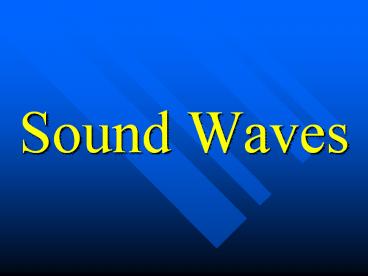Sound Waves - PowerPoint PPT Presentation
1 / 14
Title:
Sound Waves
Description:
Title: Physics 101 Author: Dr. Dan Bruton Last modified by: chris Created Date: 8/27/1998 4:32:41 AM Document presentation format: On-screen Show (4:3) – PowerPoint PPT presentation
Number of Views:304
Avg rating:3.0/5.0
Title: Sound Waves
1
Sound Waves
2
Sound...
- ...a longitudinal wave in air caused by a
vibrating object. - Produced by tiny fluctuations of air pressure
- Carried through air at 345 m/s (770 m.p.h) as
compressions and rarefactions.
3
compressed gas
wavelength
rarefied gas
4
Why is Sound Longitudinal?
- Waves in air cant be transverse, because the
molecules are not bound to each other. - Air molecules can only bump into one another.
5
Origin of Sound
- infrasonic
- frequencies lt 20 Hz
- ultrasonic
- frequencies gt 20,000 Hz
- human hearing range
- frequencies between 20 Hz and 20,000 Hz
6
Origin of Sound (Cont.)
- The frequency of an audible sound determines how
high or low we perceive the sound to be. (pitch) - greater frequency greater the pitch.
7
Nature of Sound in Air and Solids
- Speed of sound in air is related to the frantic
motions of molecules as they jostle and collide. - Solids have faster sound speeds due to close
molecule proximity molecular bonding. - dont have to rely on atoms to traverse gap
- spring compression can (and does) travel faster
than actual atom motion.
8
Example Sound Speeds
Medium sound speed (m/s)
air (25?C) 345
water 1490
gold 3240
brick 3650
wood 38004600
glass 5100
steel 5790
aluminum 5100
9
Sample Problem
- What is the approximate distance of a
thunderstorm when you note a 3 second delay
between the flash of the lightning and the sound
of the thunder? - Answer 3 seconds ? 340 meters/second
- 1020 meters
10
DOPPLER EFFECT
- a frequency shift that is the result of relative
motion between the source of the waves and the
observer. - Doppler with Sound
11
Some applications of the Doppler effect
Doppler flow meter measures speed of blood flow
in blood vessels. A transmitter generates high
frequency (5MHz) sounds that move through the
body and bounce off red blood cells. The motion
of the blood cells cause a Doppler shift in the
sound waves (in the hundreds of Hz range), that
can be measured by a receiver.
12
Some applications of Doppler effect
ultrasound image of a fetus
sonar image of a shipwreck in Lake Ontario
Ultrasound, sonar, echolocation and seismic
exploration are all ways in which machines or
animals can image the surroundings using sound
waves. A sound wave is emitted, bounces off
reflective surfaces in the environment, and the
reflected signals are observed. The time delay
between transmission and reception of the wave is
related to the distance to the reflecting
surface, transmission and reflection properties
of the media, etc., and this information can be
used to reconstruct an image of the surroundings.
13
Some applications of Doppler effect
Doppler radar used in weather forecasting to
detect local velocities in a storm system same
principle as with the Doppler effect in sound
waves, only here the frequency shift is in radio
waves bouncing off moving water droplets in a
storm.
14
Some applications of Doppler effect

